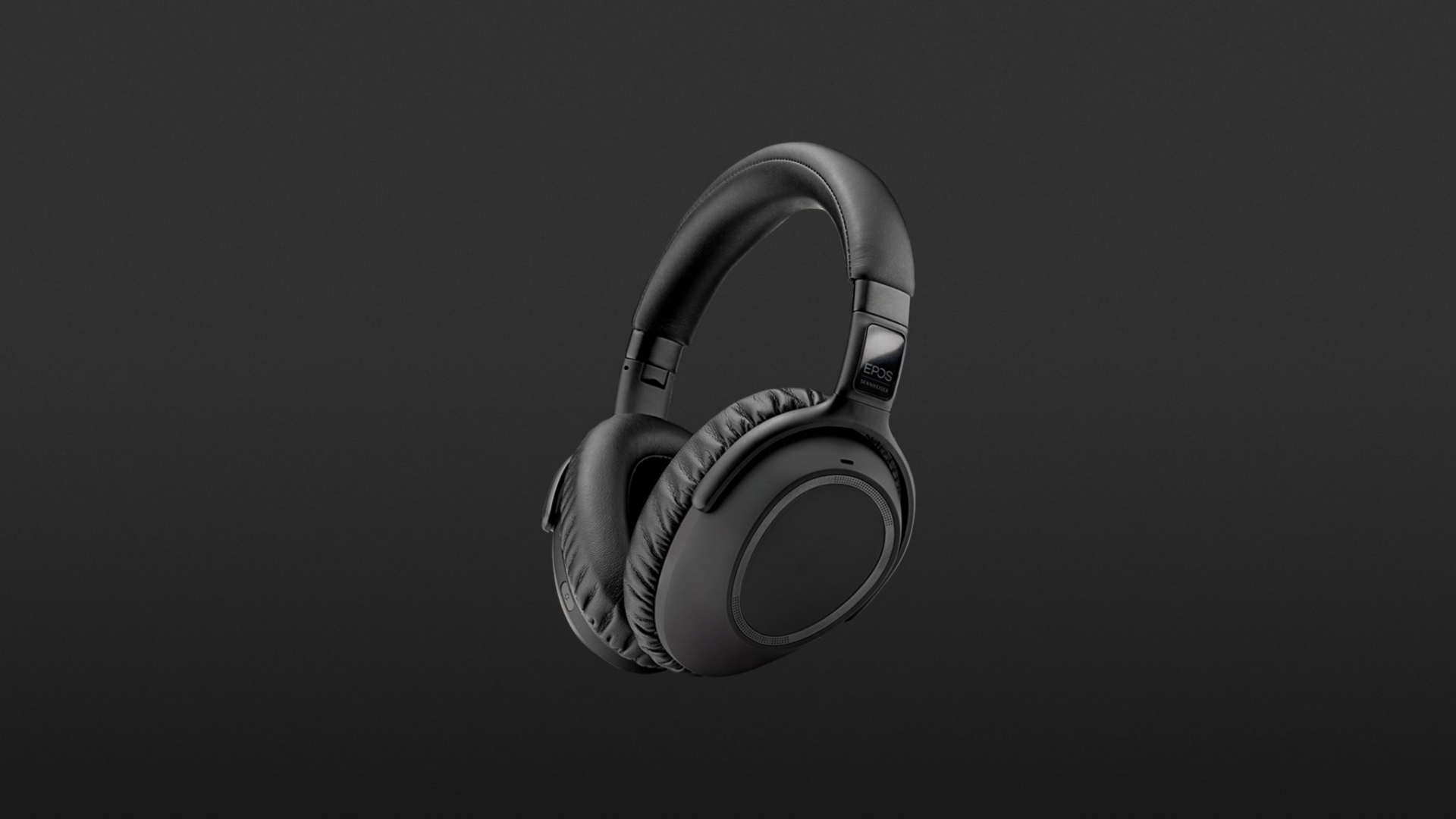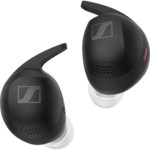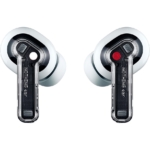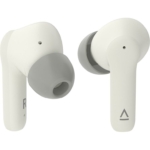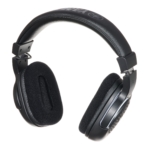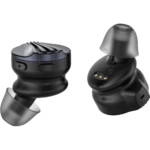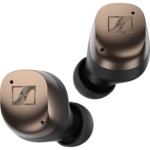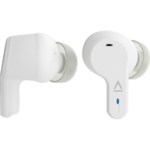The EPOS ADAPT 660 is characterised by a precise, harmonious basic sound, making the headset a true all-rounder with versatile connection options. Apart from in loud environments, there was also excellent speech intelligibility during telephone calls. In everyday office use, however, its potential is reduced due to the USB dongle’s outdated Bluetooth standard 4.2, whereas the headset supports version 5.0.
The compact, connectivity-friendly ADAPT 660 over-ear headset from EPOS is designed for professionals on the move, it offers customisation options via software and an app as well as ambient noise control. Thanks to AI technology and beamforming microphones, it is claimed that excellent voice quality can be achieved in the (home) office, while high-quality audio codecs are available for wireless media playback with aptX Low Latency, aptX and AAC.
Visually, the relationship to Sennheiser’s PXC 550-II (review) is unmistakable, although the ADAPT 660 headset is a fraction lighter at 230 grams. The fit is neither too loose nor too tight, so the headphones do not slip even if you break into a sprint, and they can be worn for longer periods without any problems. The tilting, swivelling and folding ear cups ensure that they both save space for transport in the supplied soft case and that they have a good fit. In addition, the closed over-ear system offers noticeable shielding from the environment and emits only slight noise to the outside. However, due to the design, a certain amount of heat generation must be tolerated. The leatherette padding of the oval-shaped ear cups does not provide much space, which could cause problems for larger ears. By contrast, it is an advantage that the ear pads are available as optional accessories and can thus be replaced if necessary.
Battery life
When playing media, the headset achieves a listening time of 27 hours in basic mode at a higher volume setting, and this is reduced to 25 hours when maximum noise cancellation is used. Unfortunately, the ADAPT 660 does not have a fast-charging function or a USB-C port, as power is supplied via a micro-USB socket. A complete charging cycle takes three hours and 15 minutes. However, if the headset is connected to a laptop via the supplied micro-USB to USB-A charging cable, it can also be used while charging, and a mobile device can also be connected in parallel via Bluetooth. As a further connection option, the headset is also equipped with a 2.5 mm audio input for analogue operation, and a corresponding 2.5 mm to 3.5 mm audio cable is included in the package.
Model variants
As an alternative to the ADAPT 660 with USB-A Bluetooth adapter and Micro-USB to USB-A charging cable, EPOS also offers the ADAPT 661 headset variant, which comes with USB-C Bluetooth adapter and Micro-USB to USB-C charging cable. However, the BTD 800 USB dongle only supports the somewhat outdated Bluetooth standard 4.2 and not version 5.0 like the headset, which is certainly a weakness. While the range via Bluetooth adapter was just six metres, and dropouts can occur after only four metres, the stability of the wireless connection increased significantly in combination with mobile devices so that several rooms could be bridged effortlessly. However, the Microsoft Teams certification of both models requires the use of the USB dongle or cable. Additionally, the headset is optimised for common unified communications (UC) platforms.
Operating the EPOS ADAPT 660
The ADAPT 660 is not switched on by push-button but via the swivel mechanism of the earpieces when they are placed in the wearing position. The headset then automatically connects to the Bluetooth adapter on the PC or Mac. Pairing mobile devices is a little more complicated, as the Bluetooth mode must first be switched on using the slide switch, and then pairing mode can be activated manually by pressing and holding the team button. However, the headphones do support multipoint connections with two devices simultaneously. This allows a parallel connection to the Bluetooth adapter and a smartphone or tablet, but also simultaneously with two mobile devices.
All the ADAPT 660’s controls are located on the right side of the ear cup shell, which has a touch-sensitive surface. While one tap controls playback and can be used to answer phone calls, a double tap activates and deactivates the Talk Through function, which enables communication with other people without having to take the headphones off. A short hold ends or rejects phone calls. A voice assistant or Alexa can also be called up. Swipe gestures are available, and these enable volume control with a vertical stroke. With a horizontal gesture, title navigation can be carried out, and the microphone technology can be muted. A sliding button can be used to switch between basic mode, maximum noise cancellation and adaptive noise cancelling. The Teams button can also be used to call up Microsoft Teams or make a call, while the USB dongle’s LED indicates participation in a meeting, voice messages or missed calls.
Software and app connectivity
The headset can be set up according to personal requirements via the EPOS Connect software (Windows and macOS) and the EPOS Connect app (Android and iOS). This includes activatable hearing protection, the configuration of advisory tones and multilingual voice messages, an adjustable sidetone function and the activation and deactivation of multipoint connections. Firmware updates can also be carried out. However, the noise cancellation can only be adjusted on mobile devices by setting the intensity in adaptive mode between zero and 100. Switching the wear detection on and off (Smart Pause) as well as the sound adjustment is also reserved for the app, although a classic EQ section that allows saving custom settings has been omitted. Instead, there are four pre-configured modes to choose from: “Neutral”, “Speech”, “Club” and “Film”, while parameters such as “Boost”, “Spatial”, “Reverb” or “Dynamic Loudness Compensation” can be adjusted via “Director”.
EPOS ADAPT 660 Voice Quality
In addition to four ANC microphones, the ADAPT 660 headset is equipped with three beamforming microphones and EPOS AI technology, which according to the manufacturer, means it is able to achieve high speech clarity regardless of the environment. We can confirm that the basic intelligibility was excellent, and a natural-feeling conversational situation can be created, as both sides were perceived as direct and close. The presentation was also quite loud, but this can be turned down. Wind noise hardly affected the quality of the conversation, as the other party only heard a slight whisper in the background when there was a strong gust of wind. Ambient noise was also noticeably attenuated so that one’s own voice was transmitted superficially and remained intelligible, even if the quality was reduced.
The EPOS ADAPT 660’s noise cancellation and Talk Through mode
The headset’s Talk Through function had slight background noise but amplified external noise cleanly so that a conversation could be held without any problems. However, it seems impractical that it was not obvious whether the mode is active, especially during playback, as there is no acoustic or visual feedback when switching on and off. However, the hybrid noise cancellation works with low noise and attenuates ambient noise quite broadly, even if the mid-frequency range was not filtered quite as effectively. We noticed that the static ANC mode reduced voices and low-frequency noise sources somewhat more effectively than adaptive noise cancelling and was often the better choice.
The sound of the EPOS ADAPT 660
The harmonious, balanced basic sound of the ADAPT 660 makes the headset very versatile. The support of high-quality audio codecs makes wireless media playback a listening pleasure, especially since you can benefit from a high degree of synchronicity between picture and sound when using aptX LL. A matter-of-fact reproduction with a pure sound image that does not show off any effects was characteristic. There was no emphasis on the low-frequency range, which nevertheless reached far down and was precise and tight rather than powerless. The detailed midrange also appeared neither timid nor obtrusive but conveyed a direct sound impression with verve. Voices were placed centrally, sounded pleasantly natural and had a subtle basic warmth. When listening to music, watching films, and listening to audiobooks or podcasts, the speech intelligibility was excellent. The upper registers were not loud but lively, and sibilants were reproduced rather well. Overall, there were no weaknesses to be found. On the contrary, thanks to the sharpness of the contours and a certain spatial depth, exact localisation was possible, which meant that this headset can also hold its own in the gaming sector.
Technical specifications
- Ear couplingOver-ear
- Typeclosed
- Transducer principledynamic
- Frequency response (headphones)17 – 23.000 Hz
- Impedance490 ohms/passive 46 ohms
- Sound pressure level (SPL)118 dB
- Weight with cable242 g
- Weight without cable230 g
What's in the box
- 2.5 mm to 3.5 mm audio cable
- Micro-USB to USB-A charging cable
- Bluetooth adapter
- Carrying case
Special features
- 3 product versions available
- BT codecs: SBC, AAC, aptX, aptX Low Latency
- BT version: 5.0





